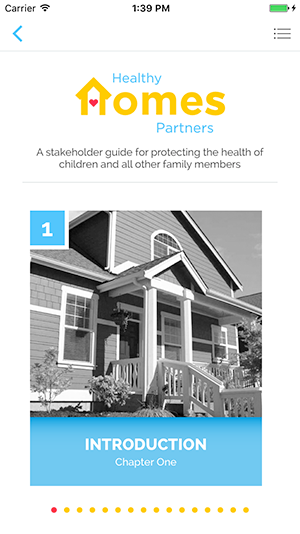
Peek’s grant leads to healthy homes app
Wednesday, October 25, 2017
Oklahoma State University associate professor in design, housing and merchandising and housing and consumer specialist Gina Peek spurred the development of a mobile phone app to identify home health hazards.
Peek, whose specialty is healthy physical home environments, applied for the grant from the U.S. Department of Housing and Urban Development (HUD) and worked with the OSU App Center to develop it.
“Based on our resources at the (OSU) App Center, I knew we had a good chance of securing the grant,” Peek said. “The App Center worked with HUD partners to develop something that many people today prefer to use to receive information.”
 Funding to develop the informational app was awarded to OSU through a competitive
grant from the HUD Office of Lead Hazard Control and Healthy Homes, its Healthy Homes
Partnership, and the U.S. Department of Agriculture’s National Institute of Food and
Agriculture. The Healthy Homes Partnership is made up of university extension services
and federal agencies.
Funding to develop the informational app was awarded to OSU through a competitive
grant from the HUD Office of Lead Hazard Control and Healthy Homes, its Healthy Homes
Partnership, and the U.S. Department of Agriculture’s National Institute of Food and
Agriculture. The Healthy Homes Partnership is made up of university extension services
and federal agencies.
Rather than a consumer guide, the Healthy Homes Partners app puts technical information and guidance in the hands of housing experts and health care providers who advise people living with dangerous health conditions.
HUD is among the key federal agencies and national sources for information about household hazards such as mold contamination, carbon monoxide poisoning, lead exposure, asthma triggers and other risks.
Participants in app testing said the checklist is one of its most valuable features. During home visits, housing experts will use the app to advise clients while inspecting each room of the home. The app then generates a report with recommendations.
“(The app) allows indoor environmental health professionals to help their clients navigate common residential health hazards and identify sources, find mitigation and removal recommendations and find more information from federal agencies,” said Dr. Michael Goldschmidt, national director of the Healthy Homes Partnership and associate teaching professor and state extension housing specialist at the University of Missouri in Columbia. “The app provides the stakeholder with specific action steps to use with their clients and a room-by-room checklist.”
Until now, that information was only available in online or in printed publications, but updating material was slow. The mobile app makes updating the information faster. For example, the app can be revised rapidly as recommendations change for what is considered dangerous blood lead levels in children.
The free Healthy Homes Partnership app is available for iOS smartphones and tablets, and more information about home health risks is found on the Healthy Homes Partnership website.
